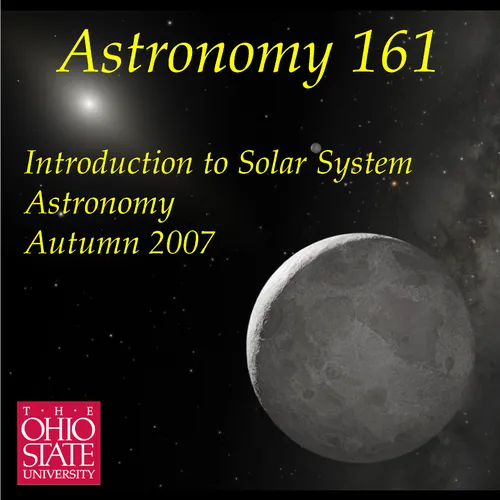
Astronomy 161 - Introduction to Solar System Astronomy - Autumn 2007
Astronomy 161, Introduction to the Solar System, is the first quarter of
a 2-quarter introductory Astronomy for non-science majors taught at The
Ohio State University. This podcast presents audio recordings of
Professor Richard Pogge's lectures from his Autumn Quarter 2007 class.
All of the lectures were recorded live in 1000 McPherson Laboratory on
the OSU Main Campus in Columbus, Ohio.
- Update frequency
- every day
- Episodes
- 49
- Years Active
- 2007 - 2009

Astronomy 141 Podcast Teaser
A new podcast, Astronomy 141, Life in the Universe, is available
for those interested in continuing an exploration of topics in
modern astronomy.
Sun 06 Dec 2009

Lecture 46: Are We Alone? Life in the Universe
Are we alone in the Universe? This lecture explores the question of how
we might go about finding life on planets around other stars. Rather
than talking about speculative ideas, like the Drake Equ…
Fri 30 Nov 2007

Lecture 45: Exoplanets - Planets Around Other Stars
Are there planets around other stars? Are there Earth-like planets
around other stars? Do any of those harbor life? Intelligent life?
We'd like to know the answers to all of these questions, and i…
Thu 29 Nov 2007

Lecture 44: Comets
Comets are chance visitors from the icy reaches of the outer Solar
System. In this lecture I describe the properties of comets, their
historical importance, and introduce the "dirty snowball" model …
Wed 28 Nov 2007

Lecture 43: Icy Worlds of the Outer Solar System
Beyond the orbit of Neptune lies the realm of the icy worlds, ranging in
size from Neptune's giant moon Triton and the dwarf planets Pluto and
Eris, all the way down to the nuclei of comets a few kil…
Tue 27 Nov 2007

Lecture 42: Asteroids
Asteroids are the leftover rocky materials from the formation of the
Solar System that reside primarily in a broad belt between the orbits of
Mars and Jupiter. This lecture reviews the physical and …
Mon 26 Nov 2007

Lecture 41: Planetary Rings
All Jovian planets have rings. We are most familiar with the bright,
spectacular rings of Saturn, but the other Jovian planets have rings
systems around them. This lecture describes the different r…
Wed 21 Nov 2007

Lecture 40: The Saturn System
Saturn is attended by a system of 60 known moons and bright, beautiful
rings. Today we will explore the moons of Saturn. Among the highlights
are Saturn's lone giant moon, Titan, the 2nd largest mo…
Tue 20 Nov 2007

Lecture 39: The Moons of Jupiter
Jupiter has its own personal solar system in miniature of 63 known
moons. Most are tiny, irregular bodies that are a combination of
captured asteroids and comets, but it is the 4 largest, the giant
…
Mon 19 Nov 2007

Lecture 38: The Ice Giants - Uranus and Neptune
The Ice Giants Uranus and Neptune are the outermost major planets of our
Solar System. Internally they small rocky cores surrounded by deep,
slushy ice mantles and shallow hydrogen atmospheres, quit…
Thu 15 Nov 2007

Lecture 37: The Gas Giants - Jupiter and Saturn
The Gas Giants Jupiter and Saturn are the largest planets in the Solar
System. Internally they are deep, heavy Hydrogen/Helium atmospheres on
top of dense rock/ice cores without solid surfaces. Wha…
Wed 14 Nov 2007

Lecture 36: Worlds in Comparison - The Terrestrial Planets
Having completed our tour of the Terrestrial Planets, we want to step
back and compare their properties. In particular, we will wi review the
processes that drive the evolution of their surfaces, th…
Tue 13 Nov 2007

Lecture 35: The Deserts of Mars
Mars is a cold desert planet with a thin, dry carbon-dioxide atmosphere.
The geology of Mars, however, shows signs of an active past, with
hot-spot volcanism, and tantalizing signs of ancient water f…
Fri 09 Nov 2007

Lecture 34: Venus Unveiled
Venus, the second planet from the Sun, is perpetually veiled behind
opaque clouds of sulfuric acid droplets atop a hot, heavy, carbon
dioxide atmosphere. In size and apparent composition, however, i…
Thu 08 Nov 2007

Lecture 33: Battered Mercury
Mercury, innermost of the planets, is a hot, dead world that has been
heavily battered by impacts. In this lecture I review the properties of
Mercury, its orbit, rotation, surface, and interior stru…
Wed 07 Nov 2007

Lecture 32: The Origin of the Solar System
How did the Solar System form? In this lecture I review the clues for
the formation of the solar system in the present-day dynamics (orbital
and rotation motions) and compositions of the planets and…
Tue 06 Nov 2007

Lecture 31: The Family of the Sun
Welcome to the Solar System! We begin our exploration of the Solar
System with an overview of the planets, moons, and small bodies that
make up our home system. In this lecture I'll introduce many …
Mon 05 Nov 2007

Lecture 30: The Moon
What physical processes have shaped the Moon? In this lecture, I
describe the surface features of the Moon (the Maria and Highlands), how
crater density tells us the relative ages of terrains, and w…
Thu 01 Nov 2007

Lecture 29: The Earth's Atmosphere
What is the composition and structure of the Earth's atmosphere? Why is
it as warm as it is, and how did it form? Today I will describe the
composition and structure of the atmosphere, the Greenhou…
Wed 31 Oct 2007

Lecture 28: Inside the Earth
What is the interior structure of the Earth? We will start our
exploration of the Solar System with our home planet Earth. This
lecture discusses the interior structure of the Earth, introducing th…
Tue 30 Oct 2007
Disclaimer: The podcast and artwork embedded on this page are the property of Richard Pogge. This content is not affiliated with or endorsed by eachpod.com.